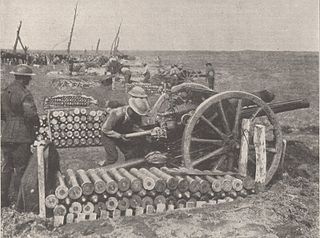
The Ordnance QF 18-pounder, or simply 18-pounder gun, was the standard British Empire field gun of the First World War-era. It formed the backbone of the Royal Field Artillery during the war, and was produced in large numbers. It was used by British Forces in all the main theatres, and by British troops in Russia in 1919. Its calibre (84 mm) and shell weight were greater than those of the equivalent field guns in French (75 mm) and German (77 mm) service. It was generally horse drawn until mechanisation in the 1930s.
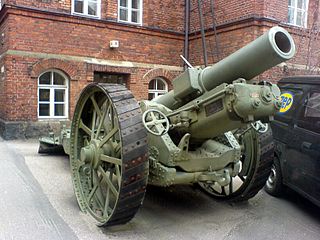
The BL 8-inch howitzer Marks VI, VII and VIII were a series of British artillery siege howitzers on mobile carriages of a new design introduced in World War I. They were designed by Vickers in Britain and produced by all four British artillery manufacturers but mainly by Armstrong and one American company. They were the equivalents of the German 21 cm Morser 16 and in British service were used similarly to the BL 9.2-inch howitzer but were quicker to manufacture and more mobile. They delivered a 200 lb (91 kg) shell to 12,300 yd. They had limited service in the British Army in World War II before being converted to the new 7.2 in (180 mm) calibre. They also equipped a small number of Australian and Canadian batteries in World War I and by the US Army in that war. They were used in small numbers by other European armies.

The Ordnance BL 6 inch 26cwt howitzer was a British howitzer used during World War I and World War II. The qualifier "26cwt" refers to the weight of the barrel and breech together which weighed 26 long hundredweight (1.3 t).
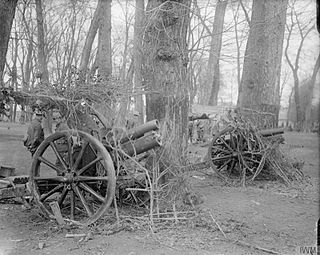
The Ordnance QF 4.5-inch howitzer was the standard British Empire field howitzer of the First World War era. It replaced the BL 5-inch howitzer and equipped some 25% of the field artillery. It entered service in 1910 and remained in service through the interwar period and was last used in the field by British forces in early 1942. It was generally horse drawn until mechanisation in the 1930s.
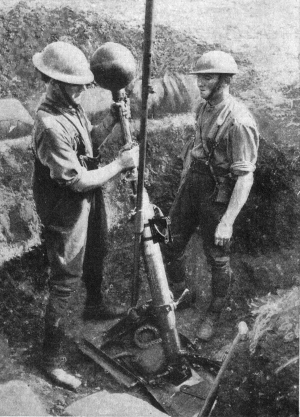
The 2 inch medium trench mortar, also known as the 2-inch howitzer, and nicknamed the "toffee apple" or "plum pudding" mortar, was a British smooth bore muzzle loading (SBML) medium trench mortar in use in World War I from mid-1915 to mid-1917. The designation "2-inch" refers to the mortar barrel, into which only the 22-inch bomb shaft but not the bomb itself was inserted; the spherical bomb itself was actually 9 inches (230 mm) in diameter and weighed 42 lb (19 kg), hence this weapon is more comparable to a standard mortar of approximately 5-6 inch bore.

The Ordnance BL 6 inch 30cwt howitzer was a British medium howitzer used in the Second Boer War and early in World War I. The qualifier "30cwt" refers to the weight of the barrel and breech together which weighed 30 hundredweight (cwt) : 30 × 112 lb = 3,360 lb. It can be identified by the slightly flared shape of the muzzle and large recuperator springs below the barrel.

The 240 mm trench mortar, or Mortier de 240 mm, was a large calibre mortar of World War I. An original French design, it was developed by Batignolles Company of Paris and introduced in 1915.

The Canon de 155 C modèle 1917 Schneider, often abbreviated as the C17S, was a French howitzer designed by Schneider. It was essentially the Canon de 155 C modèle 1915 Schneider fitted with a different breech to use bagged propellant rather than the cartridge cases used by the older howitzer. It was used by France, Russian Empire, Belgium, Romania, and the United States from 1917 during World War I and was widely exported after the war. Surviving weapons were in service with France, Poland, Greece, Italy, Belgium, the United States, and Finland during World War II. Captured weapons were used by the Germans for their 2nd-line artillery and coast defense units.

The Ordnance BL 5-inch howitzer was initially introduced to provide the Royal Field Artillery with continuing explosive shell capability following the decision to concentrate on shrapnel for field guns in the 1890s.
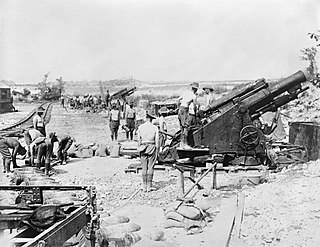
The Ordnance BL 9.2-inch howitzer was a heavy siege howitzer that formed the principal counter-battery equipment of British forces in France in World War I. It equipped a substantial number of siege batteries of the Royal Garrison Artillery. During World War II a limited number were used in the Battle of France, with the remainder being kept in the United Kingdom.
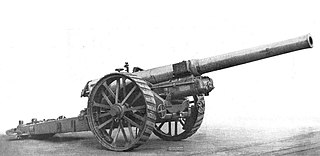
The British BL 6-inch gun Mk XIX was introduced in 1916 as a lighter and longer-range field gun replacement for the obsolescent BL 6-inch gun Mk VII.

The Ordnance BL 15-pounder, otherwise known as the 15-pounder 7 cwt, was the British Army's field gun in the Second Boer War and some remained in limited use in minor theatres of World War I. It fired a shell of 3-inch diameter with a maximum weight of 15 pounds (6.8 kg), hence its name which differentiated it from its predecessor '12-pounder' 3-inch gun which fired shells weighing only 12.5 pounds (5.7 kg).

The 3-inch Gun, Model of 1902 was the U.S. Army’s first nickel steel, quick-firing field gun with a recoil mechanism. Like its predecessor the 3.2-inch gun M1897, it was a rifled breechloader.

The 15 cm schwere Feldhaubitze 1902 was a German heavy field howitzer cannon introduced in 1903 and served in World War I.

The Type 91 10 cm howitzer was a 105 mm (4.13 in) howitzer used by the Imperial Japanese Army during the Second Sino-Japanese War and World War II. As the standard Japanese light howitzer of the period, it was influenced by Schneider designs and was considered to be light, robust and reliable. Type 91 howitzers were issued to artillery regiments where they would supplement 75mm field guns. The Type 91 number was designated for the year the gun was accepted, 2591 in the Japanese imperial year calendar, or 1931 in the Gregorian calendar.

The 152 mm howitzer Model 1910 Schneider or, more properly, 6 dm polevaja gaubitsa sistemy Schneidera as it was designated in Tsarist times, was a French howitzer designed by Schneider et Cie. It was used by the Russian Empire and the Soviet Union during World War I, the Polish–Soviet War and the Russian Civil War. Finland captured nine during the Finnish Civil War, but did not use them during that conflict. They did see combat during the Winter War and the Continuation War.

The 75 mm gun M1916 was a US Army field artillery piece used during and after World War I. It was used as an anti-aircraft gun as well as a field piece. It originated as the 3-inch gun M1913, which was soon modified to the 3-inch gun M1916, which was later altered to the subject weapon.

The 4.7-inch gun M1906 was designed and issued by the United States Army Ordnance Department beginning in 1906, with the first units receiving the weapon in 1911. It was of the field gun type. It was one of very few pre-war US artillery designs selected for wartime production in World War I, although few of these weapons were delivered to France and used in action. A combination of a limited pre-war munitions industry, the short (19-month) US participation in the war, technical problems with large-scale production, and the ready availability of munitions overseas led to this.

The 155 mm Rimailho Howitzer Model 1904TR was a medium howitzer used by France before and during World War I.
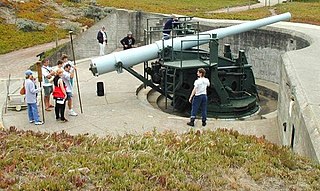
The 6-inch gun M1897 (152 mm) and its variants the M1900, M1903, M1905, M1908, and M1 were coastal artillery pieces installed to defend major American seaports between 1897 and 1945. For most of their history they were operated by the United States Army Coast Artillery Corps. They were installed on disappearing carriages or pedestal mountings, and during World War II many were remounted on shielded barbette carriages. Most of the weapons not in the Philippines were scrapped within a few years after World War II.




















